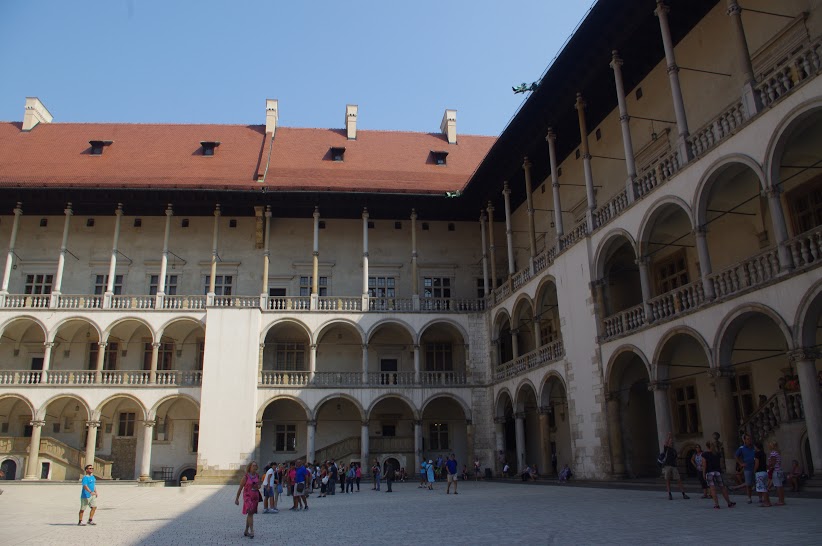 Styl renesansowy
Styl renesansowy
Styl renesansowy, nawiązujący do antyku, ceni ponad wszystko umiar i harmonię oraz ludzką miarę rzeczy (humanizm). W Krakowie, jako siedzibie dworu królewskiego, znalazł on najlepsze warunki rozwoju. Wzory czerpano z Italii, choć nie zawsze bezpośrednio, sprowadzano bowiem na przykład artystów włoskich wcześniej zatrudnionych na Węgrzech. Rzeczą ciekawą jest to, że renesans kwitł przede wszystkim w zasięgu mecenatu królewskiego, współegzystując jeszcze przez długi czas z późnym gotykiem. Dwór królewski bowiem, zamożny i otwarty na wpływy zachodnioeuropejskie, między innymi poprzez koligacje rodzinne, starał się nadążyć za nowo pojawiającymi się prądami artystycznymi i intelektualnymi, podczas gdy mieszczaństwo, bardzo konserwatywne, hołdowało starym wzorom. Dzięki upodobaniom rodziny królewskiej i dworzan, renesansowe tendencje artystyczne w porównaniu do innych krajów Europy Środkowej ujawniły się w Krakowie stosunkowo wcześnie (pocz. XVI w.), choć i tak dobre kilkadziesiąt lat po pierwszych w pełni renesansowych dziełach we Włoszech, powstałych w latach 30. XV w. Pierwszym większym przedsięwzięciem budowlanym, wprowadzającym styl renesansowy do polskiej architektury, była przebudowa dziedzińca zamku na Wawelu. Mistrzowie włoscy – Franciszek Florentczyk, a następnie Bartłomiej Berrecci – w latach 1502-1536 ozdobili królewską rezydencję okazałymi krużgankami arkadowymi. Również wnętrza wawelskie uległy renesansowym przeobrażeniom. Najbardziej reprezentacyjne sale, jak Senatorska czy Poselska, otrzymały wspaniałe kasetonowe stropy. Wymieniono też sporą część ozdobnej kamieniarki, w czym zasłużył się zwłaszcza mistrz Benedykt. Warto zwrócić uwagę na portale i obramienia okien, łączące renesansową ornamentykę z pozostałościami stylu gotyckiego. Splendoru komnatom dodała też specjalnie zamówiona w brukselskich warsztatach przez Zygmunta Augusta kolekcja arrasów. Głównym dziełem renesansu, ponoć niemającym sobie równych na północ od Alp, stała się kaplica Zygmuntowska (1519-1531) projektu wspomnianego już Berrecciego. Jej architektura o doskonałych proporcjach, z harmonijnie dopasowanymi detalami w jedyny w swoim rodzaju sposób łączyła się z przebogatą w treści dekoracją rzeźbiarską o charakterze ornamentalnym i figuralnym.
Twórcą zdobień był w sporej mierze również Berrecci. Od niego bierze swój początek rozwój renesansowej rzeźby nagrobnej w Polsce. Właśnie posąg leżącego w charakterystycznej pozie Zygmunta Starego ze stanowiącej mauzoleum grobowe kaplicy zainspirował innych wybitnych twórców, takich jak Jan Maria Padovano, Jan Michałowicz z Urzędowa czy Santi Gucci, których liczne dzieła można spotkać w świątyniach Krakowa. Z czasem, co widać zwłaszcza w dziełach Gucciego, pierwotne wzory uległy zmanierowaniu (np. nagrobek Batorego w katedrze wawelskiej), a harmonia ustąpiła miejsca przesadnej nieraz dekoracyjności.
Renesansowe malarstwo w Krakowie znalazło najpełniejszy wyraz w twórczości Stanisława Samostrzelnika (od 1519 r. nadwornego malarza Krzysztofa Szydłowieckiego) znanego głównie z miniatur książkowych, ale niestroniącego też od większych form – vide portret Piotra Tomickiego. Najcenniejszym dziełem krakowskiej sztuki zdobienia ksiąg jest jednak Kodeks Baltazara Behema o stylistyce tkwiącej jeszcze w formach gotyckich. Na uwagę zasługują również fryzy w komnatach wawelskich, malowane m.in. przez Antoniego z Wrocławia.


